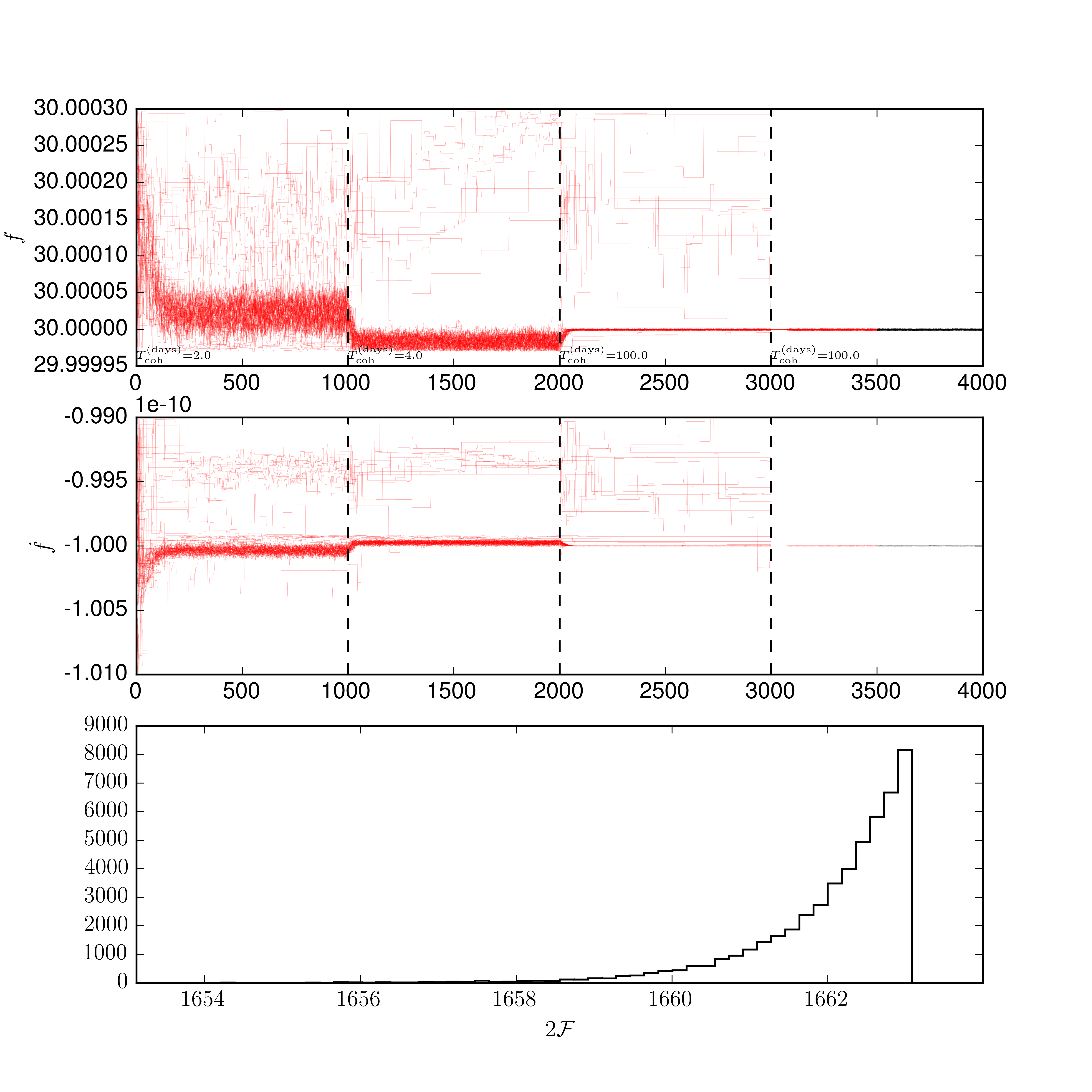Semi-coherent Follow-Up MCMC search (dynamically changing the coherence time)
Here, we will show the set-up for using the MCMCFollowUp class. The basic
idea is to start the MCMC chains searching on a likelihood with a short coherence
time; once the MCMC chains converge to the solution, the coherence time is
extended effectively narrowing the peak, afterwhich the chains again converge
to this narrower peak. The advantages of such a method are:
- Dynamically shows the evolution
- Able to handle multiple peaks and hence can result in a multi-modal posterior
The plots here are produced by follow_up.py. We
will run the search on the basic data generated in the
make_fake_data example. The basic script is here:
import pyfstat
F0 = 30.0
F1 = -1e-10
F2 = 0
Alpha = 5e-3
Delta = 6e-2
tref = 362750407.0
tstart = 1000000000
duration = 100*86400
tend = tstart + duration
theta_prior = {'F0': {'type': 'unif', 'lower': F0*(1-1e-6), 'upper': F0*(1+1e-5)},
'F1': {'type': 'unif', 'lower': F1*(1+1e-2), 'upper': F1*(1-1e-2)},
'F2': F2,
'Alpha': Alpha,
'Delta': Delta
}
ntemps = 1
log10temperature_min = -1
nwalkers = 100
run_setup = [(1000, 50), (1000, 25), (1000, 1, False),
((500, 500), 1, True)]
mcmc = pyfstat.MCMCFollowUpSearch(
label='follow_up', outdir='data',
sftfilepath='data/*basic*sft', theta_prior=theta_prior, tref=tref,
minStartTime=tstart, maxStartTime=tend, nwalkers=nwalkers,
ntemps=ntemps, log10temperature_min=log10temperature_min)
mcmc.run(run_setup)
mcmc.plot_corner(add_prior=True)
mcmc.print_summary()Note that, We use the MCMCFOllowUpSearch class. Rather than using the nstepsparameter to define how long the chains are run for, this class usesrun_setup. This is an nstagelength list (or array) which determines the number of steps, how many steps should be considered burn-in, the number of segments to use, and whether to re-initialise the walkers. Each element of the list is a 3-tuple of the form((nburn, nprod), nsegs, resetp0). However, each element can be given as a short form: either ommiting the nsteps as (nburn, nsegs, resetp0) or omiting the resetp0 as ((nburn, nsteps), nsegs), or
a combination of the two. For example, above we used
run_setup = [(1000, 50), (1000, 25), (1000, 1, False),
((500, 500), 1, True)]Here we run the first two steps with 1000 burn-in steps (such that they will be discarded) and changing the number of segments, then one 1000 burn-in steps fully coherently and finally a run with 500 burn-in and 500 production samples and a reset of the parameters at the begining. The output is demonstrated here:
Some things to note:
- The
resetp0is useful to clean-up straggling walkers, but will remove all multimodality potentially loosing information. - On the first axis the coherence time is displayed for each section
- In this example the signal is quite strong and in Gaussian noise
- The
twoFdistribution plotted at the bottom is taken only from the production run - This plot is generated after each stage of the run - this can be useful to check it is converging before continuing the simulation
